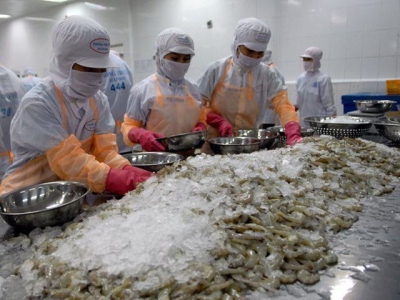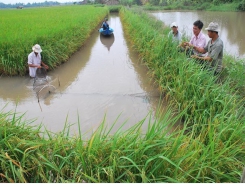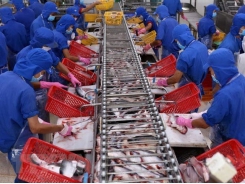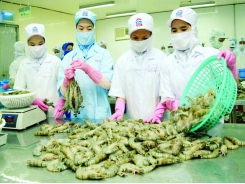Many challenges await Vietnams shrimp export to US

Ho Chi Minh City (VNA) – Various challenges face Vietnam’s shrimp exports to the US, as aside from high anti-dumping duties, Vietnamese businesses have to tackle harsh policies the US uses to protect domestic production.
Workers process frozen shrimp for export (Photo: VNA)
Over the past decade, Vietnam’s shrimp exports to the US have fluctuated between 500 million USD and more than 1 billion USD. After the peak of more than 1 billion USD in 2014, exports to the US have become stagnant, according to the Vietnam Association of Seafood Exporters and Producers (VASEP).
The figure reached 255.7 million USD in the first half of 2018, down 7.5 percent year on year. The US is currently the third biggest importer of Vietnamese shrimp, accounting for 15.6 percent of total shrimp shipments.
The US’s National Oceanic and Atmospheric Administration recently included shrimp in the Seafood Import Monitoring Programme (SIMP). Accordingly, from December 31 this year, importers have to comply with all SIMP requirements such as providing sufficient data about harvest, fishing and trips to US ports and ensuring that products are re-traceable within two years.
This new regulation is worrying many businesses and could hamper shrimp exports to this market, VASEP said.
Meanwhile, shrimp processors and exporters of Vietnam are also encountering “relatively unreasonable” protectionist measures in the US, said Vo Van Phuc – General Director of the Vietnam Clean Seafood Corporation.
For example, in early March 2018, the US Department of Commerce announced preliminary results of the anti-dumping order on frozen warm water shrimp from Vietnam. It put the preliminary rate at a record high – 25.39 percent.
Growing trade protectionism has spread from the US to other countries, especially in the Middle East where “unreasonable” barriers to aquatic products of Vietnam are being erected.
The shrimp sector as well as the fisheries industry is forecast to face more challenges in terms of tariff and technical requirements due to growing protectionism.
The decline of shrimp exports to the US is also attributed to fierce competition from other shrimp suppliers, particularly India, Indonesia and Thailand. High input cost in farming have also made shrimp prices of Vietnam higher than its rivals.
Challenges are also coming from the US-China trade war, VAEP noted, saying that because of the US’s high import tariffs, China will import less raw shrimp for processing and re-export. This could lead to a drop in Vietnam’s shipments of raw shrimp to China since raw shrimp made up 94 percent of the country’s shrimp exports to China in 2017.
Additionally, the US will examine the origin of Vietnamese shrimp more strictly as Chinese firms may take advantage of Vietnam to falsify the origin of their shrimp products.
VASEP said Vietnamese companies should consider the trade war a chance to gain a foothold by improving product quality, being more active and making better use of free trade agreements. They also need to stay updated on the list of goods subject to high tariffs of both the US and China, along with the fluctuation of the US dollar and the Vietnamese dong, to take timely actions.
Có thể bạn quan tâm
Phần mềm

Phối trộn thức ăn chăn nuôi

Pha dung dịch thủy canh

Định mức cho tôm ăn

Phối trộn phân bón NPK

Xác định tỷ lệ tôm sống

Chuyển đổi đơn vị phân bón

Xác định công suất sục khí

Chuyển đổi đơn vị tôm

Tính diện tích nhà kính

Tính thể tích ao hồ



 Eco-shrimp farming – model for sustainable aquaculture development
Eco-shrimp farming – model for sustainable aquaculture development  New US regulations expected to hurt Vietnamese shrimp…
New US regulations expected to hurt Vietnamese shrimp…